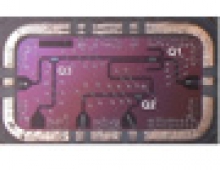
New Light Source Illuminates Path to Ultra Powerful Quantum Computers
Scientists in Cambridge have invented a novel type of light source, which could again revolutionise data processing, communications and storage applications.
The Entangled Light Emitting Diode, which is the result of collaboration between Toshiba Research Europe Limited and the Cavendish Laboratory of the University of Cambridge, was be reported today in the scientific journal Nature.
Dr Andrew Shields, who directs this work at Toshiba Research Europe, commented, "Although entangled light has been produced previously by shining an intense laser beam on crystals, the new simple device is the first voltage-powered source. The discovery is significant because it will allow electrical addressing of many entangled light emitters on a single chip, opening the path to ultra-powerful semiconductor processors based on quantum computation."
The new light source is based upon similar semiconductor Light Emitting Diode technology to that used in computer indicator lamps, traffic lights and modern household lighting and so is suitable for mass manufacture. It could therefore allow compact, cheap entangled emitters to be produced in the future and thus enable new applications that exploit the quantum properties of light.
In contrast to conventional LEDs, the entangled LED contains a tiny nanometer-scale region of semiconductor, called a quantum dot, which converts electrical current into entangled light. Dr Mark Stevenson, Senior Research Scientist on the project, explained, "For successful operation it was essential to optimise the thickness of the semiconductor material surrounding the quantum dot to control the supply of current to the dot. In addition the properties of the dot itself had to be carefully tailored to produce entangled emission."
Entangled light is a key ingredient in a quantum computer, a machine with massive processing power that will be able to solve problems that are virtually intractable otherwise, such as modelling new pharmaceuticals or materials. Other applications of entangled light include extending the range of secure communication systems based on quantum cryptography and increasing the storage capacity of optical disks.
Dr Andrew Shields, who directs this work at Toshiba Research Europe, commented, "Although entangled light has been produced previously by shining an intense laser beam on crystals, the new simple device is the first voltage-powered source. The discovery is significant because it will allow electrical addressing of many entangled light emitters on a single chip, opening the path to ultra-powerful semiconductor processors based on quantum computation."
The new light source is based upon similar semiconductor Light Emitting Diode technology to that used in computer indicator lamps, traffic lights and modern household lighting and so is suitable for mass manufacture. It could therefore allow compact, cheap entangled emitters to be produced in the future and thus enable new applications that exploit the quantum properties of light.
In contrast to conventional LEDs, the entangled LED contains a tiny nanometer-scale region of semiconductor, called a quantum dot, which converts electrical current into entangled light. Dr Mark Stevenson, Senior Research Scientist on the project, explained, "For successful operation it was essential to optimise the thickness of the semiconductor material surrounding the quantum dot to control the supply of current to the dot. In addition the properties of the dot itself had to be carefully tailored to produce entangled emission."
Entangled light is a key ingredient in a quantum computer, a machine with massive processing power that will be able to solve problems that are virtually intractable otherwise, such as modelling new pharmaceuticals or materials. Other applications of entangled light include extending the range of secure communication systems based on quantum cryptography and increasing the storage capacity of optical disks.



















